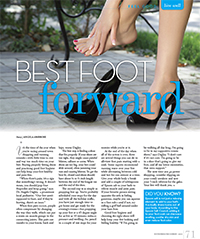 It’s that time of the year again when you’re racing around town shopping and running errands, with little time to rest and kick up your feet. Buying properly fitting shoes and practicing good foot hygiene can help keep your feet healthy and pain-free.
It’s that time of the year again when you’re racing around town shopping and running errands, with little time to rest and kick up your feet. Buying properly fitting shoes and practicing good foot hygiene can help keep your feet healthy and pain-free.
The first step is finding a shoe that fits properly. If shoes are too tight, they may cause painful blisters, calluses or corns. When shoes are too big, the foot slides around, often jamming the toes and causing blisters from heel slippage.
“When there’s pain, there’s a sign that something’s wrong. It doesn’t mean, let me pop four ibuprofen and keep going,” says Dr. Angela Dagley, podiatrist in Webster, Tex. “Our feet aren’t supposed to hurt, and if they’re hurting, there’s an issue.”
When foot pain occurs, people often compensate by changing the way they walk, which can put a strain on muscle groups in the connecting joints. This pain can transfer to your knees, back and hips, warns Dagley.
Another key consideration is buying shoes with adequate arch support and cushion. “If you’re going to do a sport, whether it be basketball, aerobics, running or tennis, you want to buy the shoe that is made for that sport,” says Dr. Barry Weinstein, podiatrist in Houston.
To get the best fit, closed toed shoes should have about ¼ to ½ inch thumb’s length between the end of the longest toe and the end of the shoe. He also suggests using the socks you plan to wear with the shoes and shopping in the afternoon because feet sometimes swell later in the day.
Other common problems include athlete’s foot and bacterial infections, especially in warm, humid climates. After bathing, Weinstein recommends drying your feet thoroughly, especially in between your toes and putting on moisturizing lotion to eliminate dry, cracked skin.
Good foot hygiene and choosing the right shoes will help keep your feet looking and feeling healthy. “If I’m going to be walking all day long, I’m going to be in my supportive tennis shoe,” says Dagley. “I don’t care if it’s not cute. I’m going to be in a shoe that’s going to give my foot and my whole lower extremity that better support.”
The next time you go power shopping, consider slipping on your comfy sneakers and save your four-inch stilettos for the office party. Your feet will thank you.
Did You Know Box
Diabetics are at high risk of foot complications, especially if their blood sugar levels are out of control. Poor blood flow and nerve damage can make them more prone to ulcers, calluses, infection and injury. “Prevention is everything,” says Dr. Barry Weinstein. “If you are proactive and check your feet regularly, then the horror stories you hear of people losing limbs can be avoided.”